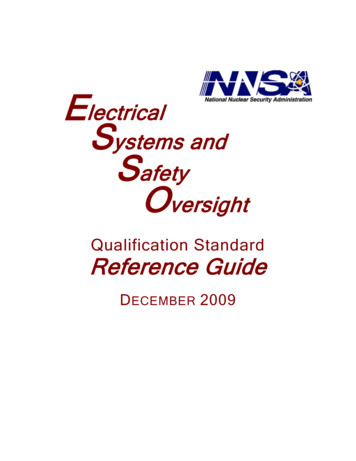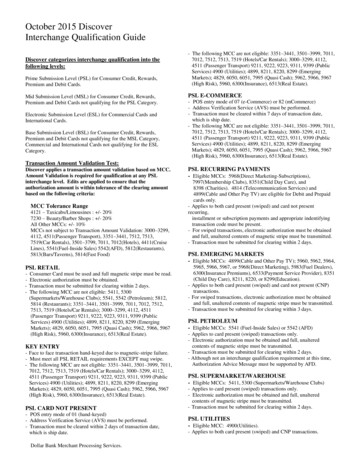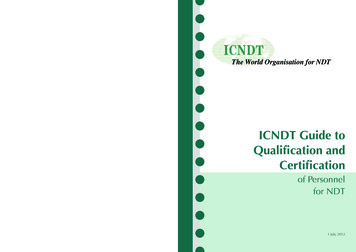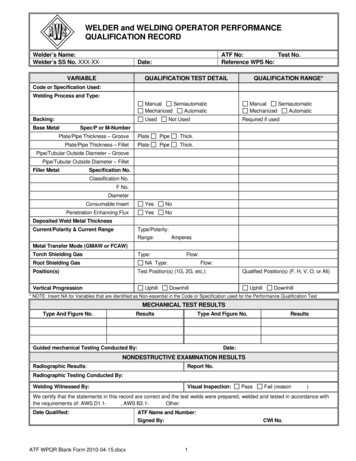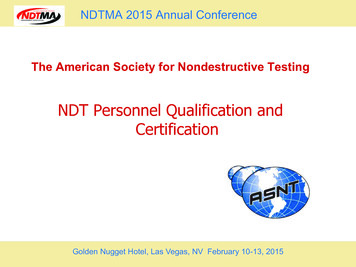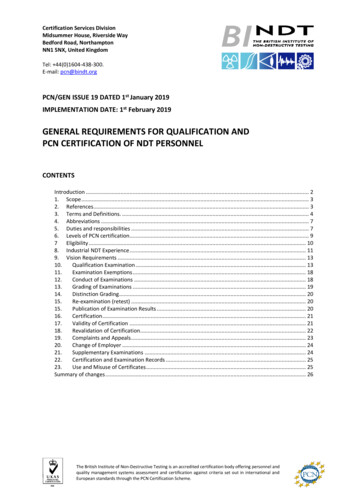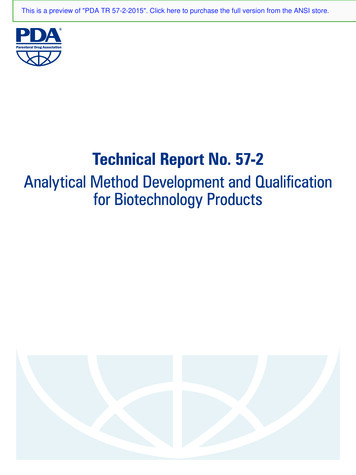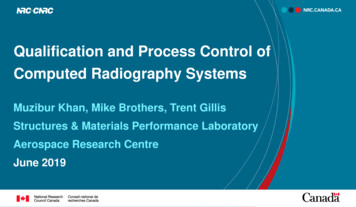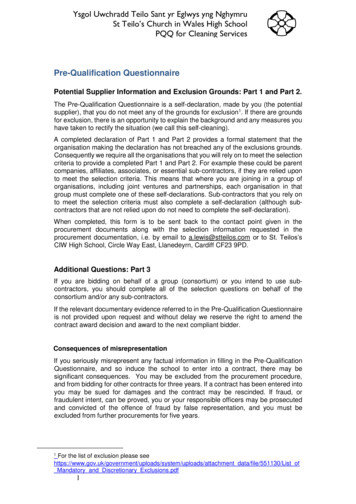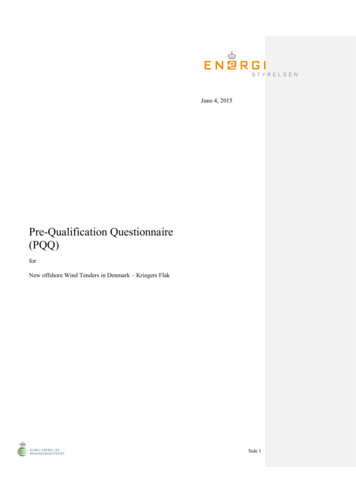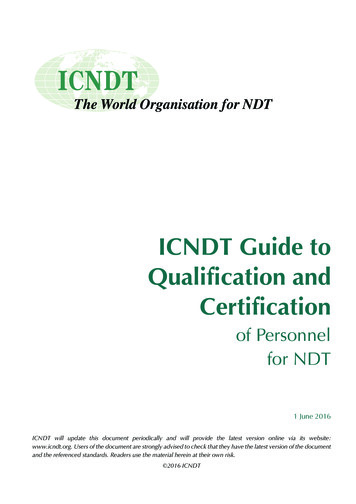
Transcription
ICNDT Guide toQualification andCertificationof Personnelfor NDT1 June 2016ICNDT will update this document periodically and will provide the latest version online via its website:www.icndt.org. Users of the document are strongly advised to check that they have the latest version of the documentand the referenced standards. Readers use the material herein at their own risk. 2016 ICNDT
2ICNDT GUIDE TO QUALIFICATION AND CERTIFICATIONOF PERSONNEL FOR NDTContentsFOREWORDS. 31. BACKGROUND. 42. RECOMMENDATIONS ON QUALIFICATION AND CERTIFICATION. 53. RESPONSIBILITIES OF THE EMPLOYER. 64. REQUIREMENTS FOR NDT PERSONNEL CERTIFICATION BODIES. 85. BIBLIOGRAPHY. 10APPENDICES. 11Appendix 1:The role of ICNDT and its regional groups in the harmonisation of qualificationand certification – Degrees of Harmonisation. 12Appendix 2:Qualification and certification of NDT personnel in accordance with ISO 9712:2012. 16Appendix 3:ICNDT membership directory. 17Appendix 4:ASME position on acceptance of central certification programmes – ICNDT perspectives. 19Appendix 5:Non-destructive testing under the European Pressure Equipment Directive (2014/68/EU). 22Appendix 6:Directory of certification bodies. 23Appendix 7:ICNDT multilateral recognition agreement, PCB assessment scheme andexamination question bank. 26Appendix 8:Qualification of NDT personnel in accordance with ISO 20807:2004 and ISO TS 11774:2011. 28Appendix 9:Guidance for developing countries seeking to establish national certification schemes. 30Appendix 10: Codes of practice and ethics for personnel certification bodies and NDT personnel. 31Appendix 11: ICNDT tabulation of PCB’s implementation of ISO 9712:2012. 33
ICNDT GUIDE TO QUALIFICATION AND CERTIFICATIONOF PERSONNEL FOR NDTForewordsForeword by Chairman of ICNDTThe competence of those carrying out non-destructive testing is an essential pre-requisite for the achievement ofquality and reliability. Qualification and certification of NDT personnel in accordance with international standards,such as the unified ISO 9712 (Non-destructive testing – Qualification and certification of personnel), helps to assurethe competence of NDT personnel and thereby assists global business and safety standards.The ICNDT, with a track record of 60 years in international cooperation in NDT, is dedicated to supporting bestpractice in the implementation of standards through this guide. As Chairman, I express thanks to my colleagues inICNDT and ISO for their assistance in preparing this document.Mike FarleyChairman, ICNDTForeword by Chairmen of ISO TC135 and CEN TC138ISO 9712 (Non-destructive testing – Qualification and certification of NDT personnel) has been harmonisedinternationally as a third-party certification standard and revised in 2012.When applying this revised and unified ISO 9712 for maintaining the integrity of materials, components, structures,facilities, etc, the ICNDT Guide to Qualification and Certification of Personnel for NDT is indispensable for theimplementation of a qualification and certification scheme.Moreover, this ICNDT Guide, which is based on long-term historical experience in supporting the implementation ofISO 9712, will provide more possibility of mutual recognition among the ICNDT member societies in the certificationof NDT personnel in order to accelerate international harmonisation.ISO/TC 135 and CEN/TC 138 expect that this ICNDT guide will be valuable both for NDT personnel requiringcertification and for the NDT industry worldwide in order to maintain safety and reliability in a wide range of industrialfields.Norikazu OokaISO TC135 ChairmanPatrick FalloueyCEN TC138 ChairmanForeword by Chairman of the PGP and Editorial CommitteeThe original guide, ‘ICNDT Recommended Guidelines for Qualification and Certification of NDT Personnel accordingto ISO 9712’, was published in June 2004 at the 16th WCNDT in Montreal, based on a first draft produced by MrG Nardoni. The first update was approved for publication at the 17th WCNDT in Shanghai. The next version waspublished to coincide with the 18th WCNDT in Durban and the agreements in ISO and CEN to unify ISO 9712and EN 473 in a new standard, ISO 9712, published in 2012. The 2014 version reflected updates in ISO 17024and the developments in the ICNDT to create an international multilateral recognition agreement and to documenthow different certification bodies are implementing ISO 9712:2012. This 2016 version reflects developments in therelationship with ASME, further information on the implementation of ISO 9712 and a reference to a code of ethicsfor certificated personnel.ICNDT will update this document periodically and will provide the latest version online via its website (www.icndt.org). Users are strongly advised to check that they have the latest version of this document and the referencedstandards. Comments and suggestions are welcome and should be sent to the ICNDT secretariat.Douglas MarshallChairman PGP and Editorial Committee3
4ICNDT GUIDE TO QUALIFICATION AND CERTIFICATIONOF PERSONNEL FOR NDT1. BackgroundThe prime purpose of this guide, which has been prepared under the auspices of the International Committee forNon-Destructive Testing (ICNDT), is to promote best practice in the qualification and certification of NDT personnelaccording to the international standard ISO 9712[1]*.The competence of NDT personnel is a key element in achieving reliability in non-destructive testing (NDT) and isvital to ensure the quality and safety of products and installations. The ICNDT Guide is of importance to all tiers in themanagement of NDT operations: regulators, inspection bodies, certification bodies, industry, NDT service companiesand supervisors of NDT personnel.The ICNDT has promoted worldwide dissemination of NDT technologies and the harmonisation of personnelcertification schemes for more than 50 years. The decision by ICNDT to promote the adoption of ISO 9712 as abasic standard for third-party qualification and certification of NDT personnel arises from the need to achieve amore consistent standard of basic knowledge and practical competence. Such standardisation becomes ever moreimportant as the globalisation of trade increases.Third-party qualification and certification is widely recognised as conferring a number of advantages:l It complies with an internationally-agreed ISO standard that is increasingly being adopted worldwide;l It utilises an internationally-developed training syllabus;l Examinations (theory and practical) are provided directly by certification bodies or through authorised qualifyingbodies and authorised examination centres under the control of certification bodies (many of which are linked tonational NDT societies);l It provides a harmonised standard for training, qualification and certification of NDT personnel and can be used as thebase level for more specific employer-based or third-party certification relevant to particular products or installations.The central role of ISO 9712 among standards for third-party certification, the historical development of NDT personnelcertification and ICNDT’s role is explained within this guide in Appendices 1 and 2, and a list of ICNDT members atthe time of writing is given in Appendix 3.The correct use of third-party qualification and certification of NDT personnel is dependent on the employers’recognition of responsibility for NDT personnel. This is important in terms of good quality management practices(outlined in ISO 9001[2] at clause 6.2 – Human Resources), product liability, meeting the requirements for accreditationand meeting the requirements of product standards and codes, such as the ASME Boiler and Pressure Vessel Code (seeAppendix 4) and the European Pressure Equipment Directive[3] (2014/68/EU – see Appendix 5). An explanation of theemployer’s responsibilities is provided in Chapter 3.In each of the regions where ICNDT has members (Africa, the Americas, Europe, the Middle East and the AsiaPacific region), ISO 9712 has been adopted as a basis for third-party certification schemes. For example, Brazil,Argentina, Colombia and Mexico have accredited certification schemes that comply with ISO 9712, and Canadaalso has a certification scheme based on the standard. In the USA, the American Society for Nondestructive Testing(ASNT) introduced ANSI/ASNT standard CP 106[4], which is closely aligned with ISO 9712:2005 and is currentlyworking towards a version based on ISO 9712:2012. Many other countries in Latin America: Uruguay, Peru, Boliviaand Venezuela, are developing national schemes based on ISO 9712. In Africa, South Africa has an accredited ISO9712-based certification system and Tunisia is introducing a similar system. In the Asia-Pacific region, Australia isaccredited to ISO/IEC 17024 and delivering ISO 9712 certifications. China provides certification to ISO 9712:2012under ICNDT approval. Other countries have foreign CBs providing certification to ISO 9712 or operating a schemewith compliance to ISO 9712 but which is unaccredited. In Europe, a large number of countries have schemes thatcomply with ISO 9712. A listing of certification schemes and their current status is provided in Appendix 6.The widespread adoption of an international standard has brought significant harmonisation but not completeuniformity. Within the terms of the standard, a certification body has options to choose the sectors in which it offerscertification and to set its own questions and practical examinations. It also chooses the languages in which it provides* The reference numbers given in square brackets refer to the documents listed in Chapter 5, Bibliography.
ICNDT GUIDE TO QUALIFICATION AND CERTIFICATIONOF PERSONNEL FOR NDTexaminations. In order to avoid a threat to the harmonisation process, ICNDT Working Group 1 ‘Qualification andcertification of NDT personnel’ has produced a report on the interpretation of ISO 9712:2012, which has an advisorynature only. This report is available on the ICNDT website at http://bit.ly/1WCWiva. It is hoped that ISO TC 135will take this report into account when a new revision of ISO 9712 is produced. In addition, Working Group 1 isundertaking a task dealing with practical examinations and the functions and responsibilities of certification bodies,authorised qualification bodies and examination centres.The ICNDT is endeavouring to promote international recognition of third-party certification schemes through a globalmultilateral recognition agreement (MRA) and details are given in Appendix 7. In many countries around the world,certification bodies that provide ISO 9712 certification have gained accreditation or approval by government agenciesor accreditation bodies to ISO 17024[5] in both voluntary and regulatory sectors. This is discussed in Chapter 4.The next systematic review of ISO 9712 is not scheduled until 2017 but, at the time of writing, there is no firminformation on plans for revision of the standard.Details of other approaches to NDT personnel certification are covered by EN 4179[6] (for aerospace certification) andSNT TC 1A[7] (for in-company certification). In certain circumstances it may be necessary or desirable, for economic orsafety reasons, to qualify NDT personnel for specified limited applications and standards covering this are describedin Appendix 8.2. Recommendations on qualification and certificationRecommendations to users of central third-party certificationWhen central third-party certification is appropriate, it is recommended that regulators and industry define the levelsof competency of NDT personnel who are certified in accordance with ISO 9712[1] by a certification body accreditedto ISO/IEC 17024[5]. Certification bodies registered under the ICNDT Multilateral Recognition Agreement (http://bit.ly/1Te9Lcd) will meet this requirement. Such bodies will have demonstrated independent evidence of accreditationto ISO/IEC 17024 and compliance with ISO 9712, either by a national or international accreditation body or by aconformity assessment carried out by ICNDT (http://bit.ly/1V7IrvL).Regulators, users and auditors of NDT operations should recognise the importance of employers of NDT personnelproperly fulfilling their responsibilities to authorise personnel to work after first confirming that their employees areadequately trained, experienced and qualified.Recommendations to certification bodiesCertification bodies are urged to provide certification to ISO 9712 in order to maximise the value of their certification.In anticipation of future harmonisation, their training syllabuses should encompass the requirements of ISO/TR25107[8].National NDT societies s
ISO 9712 (Non-destructive testing – Qualification and certification of NDT personnel) has been harmonised internationally as a third-party certification standard and revised in 2012. When applying this revised and unified ISO 9712 for maintaining the integrity of materials, components, structures,
